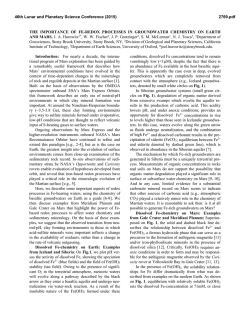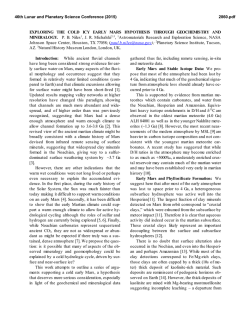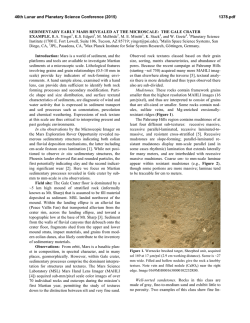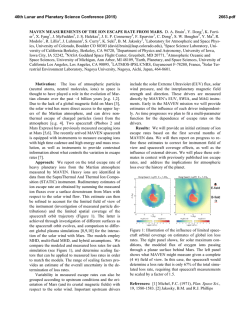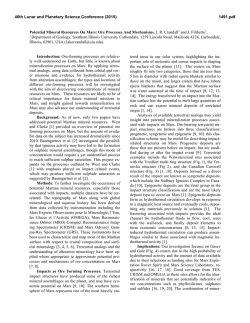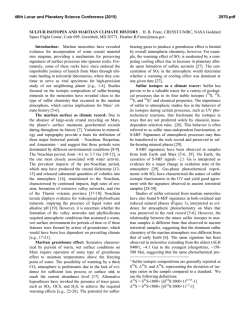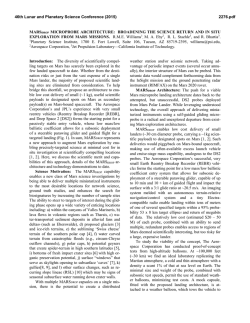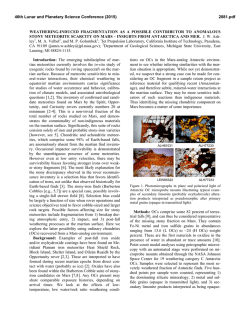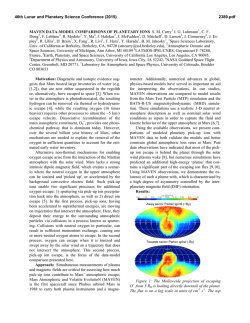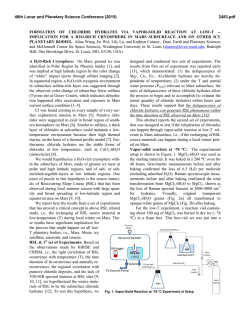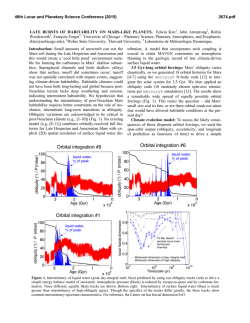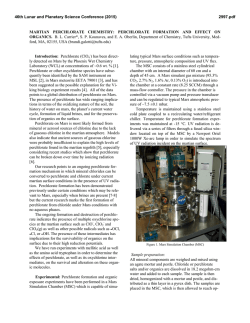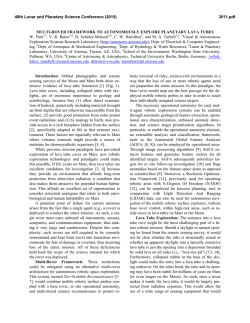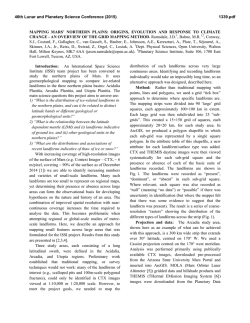
Water Loss and the Net Oxidation of the Atmosphere Recorded in
46th Lunar and Planetary Science Conference (2015) 2796.pdf WATER LOSS AND THE NET OXIDATION OF THE ATMOSPHERE RECORDED IN THE ANCIENT SEDIMENTARY RECORD OF MARS? J. A. Hurowitz1*, W. W. Fischer2, R. E. Milliken3, N. J. Tosca4, 1 Department of Geosciences, Stony Brook University, Stony Brook, NY, 2Division of Geological and Planetary Sciences, California Institute of Technology, 3Department of Earth, Environmental and Planetary Sciences, Brown University, 4Department of Earth Sciences, University of Oxford, *[email protected]. Abstract: Observations from orbiters and in-situ experiments have shown that the sedimentary rocks at Meridiani Planum, Mars were formed in an evaporative environment in the presence of acidic surface waters [1, 2]. The water was thought to be brought to the surface by groundwater upwelling [3]. The widespread presence of the mineral phase jarosite demands oxidizing conditions with pH values ranging from ca. 2-4 for these upwelling fluids. A combination of oxidation/evaporation experiments on Fe-bearing fluids [4], studies of analogue environments in Western Australia [5], and geochemical calculations, constrained by chemical and mineralogical data from the Mars Exploration Rover Opportunity [6], have demonstrated that Fe-oxidation and the precipitation of Fe3+-minerals during evaporation generates significant acidity, and provide a compelling explanation for low pH conditions at Meridiani Planum. Accordingly, we have suggested that waters of near neutral pH and rich in Fe2+ were rapidly acidified as Fe was oxidized under evaporative conditions at the Martian surface [6]. More recent results from potentially older sedimentary rocks analysed by the Mars Science Laboratory Curiosity at Yellowknife Bay in Gale Crater provide evidence for neutral pH environments in which Feoxidation was not a significant factor in the fluid chemistry [7-9]. Higher in the Gale stratigraphy, however, the presence of a discrete, hematite-rich stratigraphic interval and overlying sulfate-rich units suggest that Fe-oxidation and evaporation processes became more important as deposition within Gale Crater proceeded [10, 11]. The contrast in redox and environmental conditions within and between these two sites is striking and hints at the activation of a process that simultaneously removed water from, and added potent atmospheric oxidants to, the Martian surface environment. Early results from the Imaging Ultraviolet Spectrograph (IUVS, Figure 1) and Suprathermal and Thermal Ion Composition (STATIC) instruments onboard NASA’s Mars Atmosphere and Volatile EvolutioN (MAVEN) mission (see results page at: http://lasp.colorado.edu/home/maven/) indicate that the dissociation of H2O in the Martian atmosphere results in preferential loss of hydrogen to space relative to oxgen, presumably leaving behind an atmosphere that is more H2O-poor and O2-rich. These exciting observations of atmospheric reactions and loss processes could provide an explanation for the change in environmental conditions recorded in the sedimentary strata at Meridiani Planum and Gale Crater. If the modern processes being observed by MAVEN are in fact responsible for the changes faithfully recorded in the ancient rock record of Mars, then it suggests that they have been active for multiple billions of years. In this contribution, we will explore the interdependence between atmospheric processes and the chemical signature of fluids preserved in Martian sedimentary rocks. Figure 1: IUVS false-color images show Mars from an altitude of 36,500 km in three ultraviolet wavelength bands. Blue shows the ultraviolet light from the sun scattered from atomic hydrogen gas in a cloud thousands of kilometers above the planet’s surface. Green shows a different wavelength of ultraviolet light that is primarily sunlight reflected off of atomic oxygen, showing the smaller oxygen cloud. Red shows ultraviolet sunlight reflected from the planet’s surface. The oxygen gas is held close to the planet by Mars’ gravity, while lighter hydrogen gas is present to higher altitudes. These gases derive from the breakdown of water and carbon dioxide in Mars’ atmosphere. (This caption is adapted from a longer version posted at http://lasp.colorado.edu/home/maven/iuvs-first-light/. Image credit: Laboratory for Atmospheric and Space Physics /University of Colorado; NASA). References: [1] Grotzinger, J.P., et al. (2005) EPSL 240, 11-72. [2] Squyres, S.W., et al. (2009) Science 324, 1058-1061. [3] Andrews-Hanna, J., et al. (2010) JGR 115, E06002, doi:10.1029/2009JE003485. [4] Tosca, N., et al. (2008) JGR 113, doi:10.1029/2007JE003019, 2008. [5] Baldridge, 46th Lunar and Planetary Science Conference (2015) A.M., et al. (2009) GRL 36, 6. [6] Hurowitz, J.A., et al. (2010) Nature Geoscience 3, 323-326. [7] Grotzinger, J.P., et al. (2014) Science 343, 10.1126/science.1242777. [8] Tosca, N.J. and Hurowitz, J.A., in 2014 Goldschmidt: Sacramento, CA. [9] Vaniman, D.T., et al. (2013) Science 343, 10.1126/science.1243480. [10] Fraeman, A.A., et al. (2013) Geology 41, 1103-1106. [11] Milliken, R.E., Grotzinger, J.P., and Thomson, B.J. (2010) GRL 37, 10.1029/2009gl041870. 2796.pdf
© Copyright 2025
